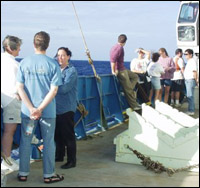One thing leads to the next
When Cann and expedition chief scientist Donna Blackman made a 1996 visit to the dome, they made some intriguing bathymetry maps showing corrugations and what appeared to be a back-tilted hanging wall being undercut by a footwall. These, as well as intriguing gravity analyses and sidescan sonar findings, cried out for a return to the site to explore two possible models for the mountain's evolution.

Fig. 6. After the final Alvin dive - the scientific party ready to go home.
One model hypothesized that plate spreading along the Mid-Atlantic Ridge could pull a lower block of ocean floor crust out from under an upper one along a shallow-angled detachment fault, hence uplifting the massif. That system would be similar to the "basin-and-range geology" that John studies in the western United States,
The other model proposed that seawater could come into contact with underlying mantle rocks during the formation of new ocean crust. The resulting serpentinization of those rocks could cause them to expand enough to push the mountain up.
Sitting at a computer terminal in Atlantis's main laboratory, Blackman, a geophysicist from the Scripps Institution of Oceanography, said the work to answer those questions is just beginning. But she was sure of one thing. "We had a really good group of people who know how to roll with the punches," she added.

Fig. 7. Work goes on. Duke grad students Nick Bacher (left, rear) and Peter Rivizzigno computer-combining Argo-II images of a vent structure into a composite.
"We did come back, and we did pick up lots of samples and we did a lot of mapping," she continued. "Things that we saw when we returned to the area were not what we expected. We did not see definitive evidence of the cap of the dome as a fault surface. But I think at this stage both hypotheses are still viable.
Until there is on-shore analysis we won't be able to say more about it. This is just the first part of a three year project."
Today's pages:
Wrapping up | Where we stand | A new kind of hydrothermal vent | One thing leads to the next
As we come to the close of this expedition, the earthguide team at CalSpace/SIO thanks you for participating in this live expedition and welcomes you to join us again as we travel to other destinations. Bookmark our site earthguide.ucsd.edu and check back!
earthguide - students, teachers and scientists working together to communicate earth science
|
|






